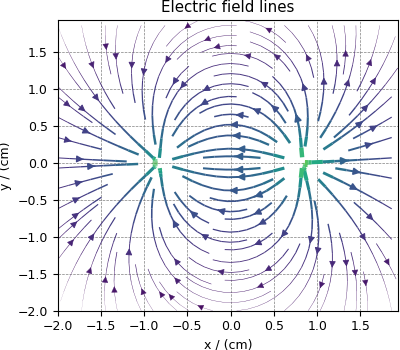Vector, 2D{2} datasets¶
The 2D{2} datasets are two-dimensional, \(d=2\), with one two-component dependent variable, \(p=2\).
Vector dataset¶
The following is an example of a simulated electric field vector dataset of a dipole as a function of two linearly sampled spatial dimensions.
>>> import csdmpy as cp
>>> filename = 'Test Files/vector/electric_field/electric_field_raw.csdfe'
>>> vector_data = cp.load(filename)
>>> print (vector_data.data_structure)
{
"csdm": {
"version": "1.0",
"read_only": true,
"timestamp": "2014-09-30T11:16:33Z",
"description": "A simulated electric field dataset from an electric dipole.",
"dimensions": [
{
"type": "linear",
"count": 64,
"increment": "0.0625 cm",
"coordinates_offset": "-2.0 cm",
"quantity_name": "length",
"label": "x",
"reciprocal": {
"quantity_name": "wavenumber"
}
},
{
"type": "linear",
"count": 64,
"increment": "0.0625 cm",
"coordinates_offset": "-2.0 cm",
"quantity_name": "length",
"label": "y",
"reciprocal": {
"quantity_name": "wavenumber"
}
}
],
"dependent_variables": [
{
"type": "internal",
"name": "Electric field lines",
"unit": "C^-1 * N",
"quantity_name": "electric field strength",
"numeric_type": "float32",
"quantity_type": "vector_2",
"components": [
[
"3.7466873e-07, 3.3365018e-07, ..., 3.5343004e-07, 4.0100363e-07"
],
[
"1.6129676e-06, 1.6765767e-06, ..., 1.846712e-06, 1.7754871e-06"
]
]
}
]
}
}
The tuples of the dimension and dependent variable instances from this example are
>>> x = vector_data.dimensions
>>> y = vector_data.dependent_variables
with the respective coordinates (viewed only up to five values), as
>>> print(x[0].coordinates[:5])
[-2. -1.9375 -1.875 -1.8125 -1.75 ] cm
>>> print(x[1].coordinates[:5])
[-2. -1.9375 -1.875 -1.8125 -1.75 ] cm
In this example, the components of the dependent variable are
vectors as seen from the
quantity_type
attribute of the corresponding dependent variable instance.
>>> print(y[0].quantity_type)
vector_2
From the value vector_2, vector indicates a vector dataset, while 2 indicates the number of vector components.
Visualizing the dataset
Let’s visualize the vector data using the streamplot method from the matplotlib package. Before we could visualize, however, there is an initial processing step. We use the Numpy library for processing.
>>> import numpy as np
>>> X, Y = np.meshgrid(x[0].coordinates, x[1].coordinates)
>>> U, V = y[0].components[0], y[0].components[1]
>>> R = np.sqrt(U**2 + V**2)
>>> R/=R.min()
>>> Rlog=np.log10(R)
In the above steps, we calculate the X-Y grid points along with a scaled magnitude of the vector dataset. The magnitude is scaled such that the minimum value is one. Next, calculate the log of the scaled magnitude to visualize the intensity on a logarithmic scale.
And now, the plot.
Tip
Streamplot vector visualization
>>> import matplotlib.pyplot as plt
>>> def plot_vector():
... plt.figure(figsize=(4,3.5))
... plt.streamplot(X.value, Y.value, U, V, density =1,
... linewidth=Rlog, color=Rlog, cmap='viridis')
...
... plt.xlim([x[0].coordinates[0].value, x[0].coordinates[-1].value])
... plt.ylim([x[1].coordinates[0].value, x[1].coordinates[-1].value])
...
... # Set axes labels and figure title.
... plt.xlabel(x[0].axis_label)
... plt.ylabel(x[1].axis_label)
... plt.title(y[0].name)
...
... # Set grid lines.
... plt.grid(color='gray', linestyle='--', linewidth=0.5)
...
... plt.tight_layout(pad=0, w_pad=0, h_pad=0)
... plt.show()
>>> plot_vector()

